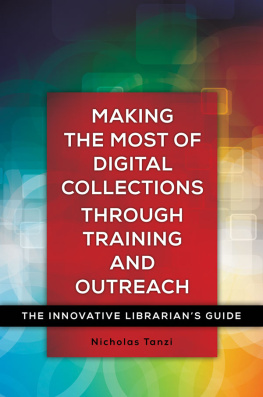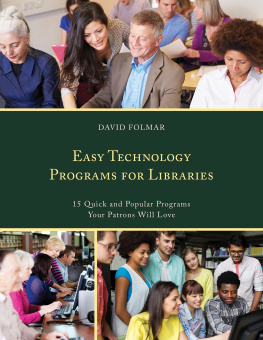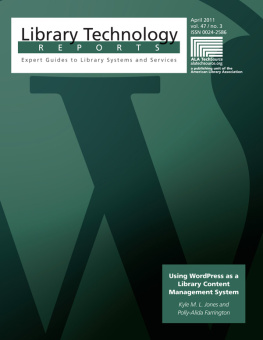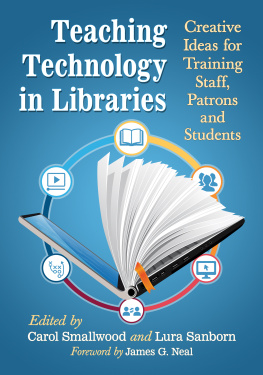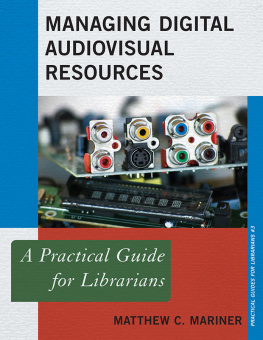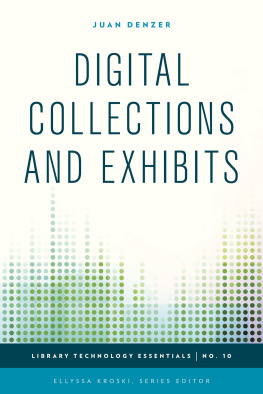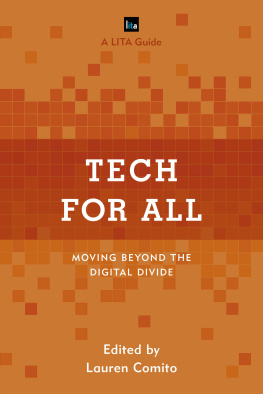Making the Most of Digital Collections Through Training and Outreach
Recent Title in Libraries Unlimiteds
Innovative Librarians Guide Series
Digitizing Audiovisual and Nonprint Materials: The Innovative Librarians Guide
Scott Piepenburg
Copyright 2016 by Nicholas Tanzi
All rights reserved. No part of this publication may be reproduced, stored in a retrieval system, or transmitted, in any form or by any means, electronic, mechanical, photocopying, recording, or otherwise, except for the inclusion of brief quotations in a review, without prior permission in writing from the publisher.
Library of Congress Cataloging-in-Publication Data
Names: Tanzi, Nicholas, author.
Title: Making the most of digital collections through training and outreach: the innovative librarians guide / Nicholas Tanzi.
Description: Santa Barbara, CA : Libraries Unlimited, [2016] | Series:Innovative librarians guide | Includes bibliographical references and index.
Identifiers: LCCN 2015031398| ISBN 9781440840722 (paperback) | ISBN 9781440840739 (ebook)
Subjects: LCSH: LibrariesSpecial collectionsElectronic information resources. | BISAC: LANGUAGE ARTS & DISCIPLINES /
Library & Information Science / Collection Development. |
LANGUAGE ARTS & DISCIPLINES / Library & Information Science / Cataloging & Classification.
Classification: LCC Z692.C65 T36 2016 | DDC 025.2/84dc23
LC record available at http://lccn.loc.gov/2015031398
ISBN: 978-1-4408-4072-2
EISBN: 978-1-4408-4073-9
201918171612345
This book is also available on the World Wide Web as an eBook.
Visit www.abc-clio.com for details.
Libraries Unlimited
An Imprint of ABC-CLIO, LLC
ABC-CLIO, LLC
130 Cremona Drive, P.O. Box 1911
Santa Barbara, California 93116-1911
This book is printed on acid-free paper 
Manufactured in the United States of America
Contents
I wish to express my gratitude to:
My friends and family for their encouragement.
My coworkers at the community library for their hard work and dedication to public service, which allows our organization to flourish.
Thank you to the following individuals without whose contributions and support this book would not have been written:
My wife, Kristine, for her love (always) and support during the writing process. Patience is a virtue and she showed an abundance of it while I delayed painting the babys room.
Sara Roye, graphic artist extraordinaire. Her skill in design is matched only by her generosity.
Dan Costa for checking my math and supplying advice and sarcasm in equal measure.
Lise Dyckman for guiding me along the winding road that leads from a concept to a published book.
In just a few short years, library collections have gone increasingly digital. According to Library Journal, in 2014, 95 percent of public libraries now offer eBooks to their patrons (Factually 2014). Far from being an amenity, eBooks have become an expectation. In addition to eBooks, libraries are adding to their collection streaming movies and music, audiobooks and eMagazines. Weve come a long way! However, as is often the case with change, there have been challenges.
As Head of the Digital Services Department at the Mastics-Moriches-Shirley Community Library (MMSCL), a great deal of my responsibilities involves the librarys digital collection. I am responsible for overseeing the acquisition of digital books, audiobooks, movies, music, and magazines. I likewise manage staff and patron technology training, including the use of the librarys digital collection.
MMSCL is a large library serving 60,000 patrons across four towns, plus contract patrons from three additional towns, who have the option to renew their cards with us annually. We are part of a loose consortium of libraries in Suffolk County, New York, who pool some resources together in the form of consolidated orders, but exercise a tremendous amount of autonomy. We serve a diverse community with large disparity in income. Many of our patrons rely on public transportation. While these complexities present their own unique set of challenges, our patrons and staff members experiences in trying to access eContent are very similar to whats happening in public libraries all over the country. Based on what weve seen, I have identified the following barriers to a successful digital collection.
Lack of Awareness
While the majority of libraries are offering eBook services, it is also true that the majority of our patrons are unaware of them! According to the American Library Association, 60 percent of library patrons dont know their library lends eBooks (Forbes 2014). A librarys digital collection is doomed to failure if the majority of our stakeholders dont know it exists. If our patrons dont know about our eBook collection, chances are theyre not looking for emerging library services such as streaming music and video. Digital collections are ideal for the patron who doesnt walk through your door on a regular basisbut how do you reach them?
Bad Prior Experience
Perhaps more detrimental to the success of a librarys digital collection is not the patron who is unaware of our service, but the patron who tried and was dissatisfied with it. In the early days of library eBook services, the user interface was often poorly constructed, particularly when compared with commercial models (NOOK store, Amazon). Digital Rights Management (DRM), intended to protect copyright, was cumbersome and could present a barrier to downloading an eBook. Additionally, many devices were not compatible with some eBook services. Overdrive, for example, experienced a period during which their collection was incompatible with the Amazon Kindle. The Kindle is a dominant force in eReading, and libraries were left turning away these patrons. While some have undoubtedly discovered they can now borrow eBooks from their library, whos to say how many are still under the impression that they cannot? Clearly, we must create a better user experience. This improved model must then be communicated to our patrons.
Lack of Familiarity
Imagine yourself at the car dealership. The salesman is trying to get you to buy the latest model sports car, but is unable to answer your questions. Gas mileage? Not sure. What type of engine? Let me talk to one of the other salespeople. Upon further investigation, its clear hes never even driven before! In this scenario, its pretty unlikely that youre buying a car from that dealership. Without a firm grasp of your librarys digital collection, it is likely that the staff will have comparable interactions with the public. To many, the idea of borrowing digital materials from their library is a new one, and they look for the staff to instill confidence in them, and not further confuse them.
Unfortunately, staff training is a journey, not a destination. Even if you could snap your fingers and magically train all your librarys staff in a services use, how long would that dream scenario last? Services are subject to change over time. Your institution will experience turnover and new staff will need to be trained. Staff members who dont continue using the service will forget their training. Your library will undoubtedly add new digital collections, which will require instructing them on its use.
Hesitancy by the Public to Try Something New
To a lot of people, change is uncomfortable. Many of your patrons are used to borrowing traditional print and analog media from their library. The idea of borrowing digital media is a new one. As a precursor to borrowing library digital media, your patrons will likely need an e-mail address. While most do have one, not all will. A more substantial requirement is that they must have a computer, laptop, smartphone, eReader, or tablet. Those that do not may be hesitant to go out and purchase one as a precursor to using services they are unfamiliar with.

